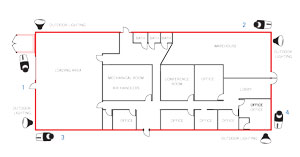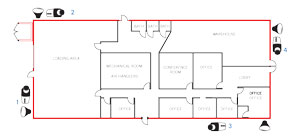1. Daytime natural lighting from the sun with a light cloud cover is approximately
a. 100,00 lux.
b. 70,000 lux.
c. 25,000 lux.
d. 2,000 lux.
2. One foot candle is approximately equal to
a. .1 lux.
b. 1 lux.
c. 10 lux.
d. .01 lux.
3. Depth of field is inversely proportional to the f-number of the lens.
a. True
b. False
4. More light __________ from the source means more light reaches the camera imager.
a. absorbed
b. delivered
c. generated
d. reflected
5. Lenses are categorized by their ability to pass light. That is reflected in a lens’
a. AES rating.
b. f-stop.
c. AGC rating.
d. all of the above
6. If the scene lighting is not sufficient for the settings chosen, one choice for improving the image is
a. lowering the sensitivity of the camera.
b. relocating the target area to one that has more lighting.
c. lowering the f-number of the lens.
d. advising the customer that the application is not proper for CCTV.
7. When the image is subject to excessive lighting from behind the image, some cameras have the ability to compensate for it by adjusting the
a. ABC.
b. TLC.
c. AGC.
d. BLC.
8. In photography, which of the following lens focal lengths is considered standard?
a. 10 mm
b. 28 mm
c. 50 mm
d. 150 mm
9. In CCTV, which of the following lens focal length is considered standard?
a. 2.8mm
b. 4 mm
c. 8 mm
d. 16 mm
10. The higher the lens’ f-number, the more light passes through the lens.
a. True
b. False
11. How is the light transmitted through a lens changed when the f-stop number on a lens is changed from f/2.0 to f/1.4? The light
a. doubles.
b. reduces by half.
c. increases by 60 percent.
d. cuts the image on the lens in half.
12. Depth of field is directly proportional to the focal length of the lens.
a. True
b. False
13. Increasing the amount of light passing through a lens improves the contrast and picture image quality.
a. True
b. False
14. As light moves away from the source, the lux decreases. This relationship is expressed by the
a. Pythagorean theorem.
b. Olin’s law.
c. Inverse square law.
d. Law of diminishing returns.
15. The higher the wavelength rating in nanometers, the more visible the light becomes.
a. True
b. False
What’s Wrong With This?
A building owner contracted for four cameras to watch his exterior doors because materials were being removed without authorization at night. He installed high wattage lights so the parking lot was as well lit as daylight. The installer placed the cameras as shown. They worked perfectly during the day but at night all that the monitor showed was a bloom. Hint: The installer did not use infrared day/night cameras.

|
Answer to: What’s Wrong With This?
The alarm technician used cameras with auto iris lenses that compensate for any differential in lighting. However, because the cameras were pointed directly towards the nighttime lighting, the cameras iris couldn’t compensate for the extreme lighting. The installer should have installed the cameras with the lights behind the camera, which would allow the auto iris lens to properly operate and provide quality nighttime video.

|
5-Minute Tech Quiz Answers
1. b
2. c
3. a
4. d
5. b — F/stop is a ratio between the diameter of the aperature of the lens and the focal length of the lens.
6. c
7. d — This is a feature called back light compensation. It adjusts for areas of brightness behind the subject.
8. c
9. b — In photography 50mm is considered standard. This is due to the imager size in CCTV cameras.
10. b
11. a
12. b — Depth of field is related to how much light is passing through the lens.
13. a
14. c
15. b




